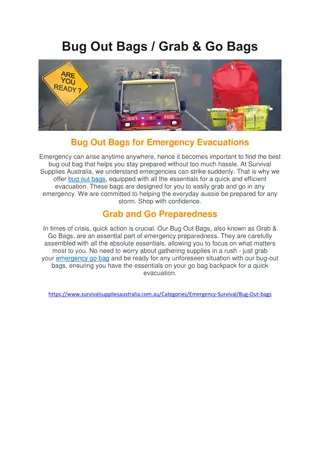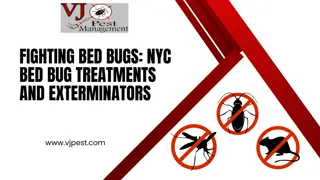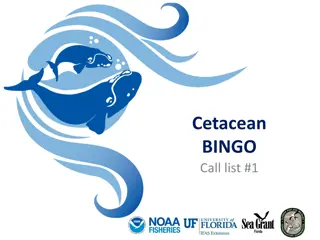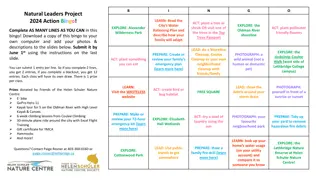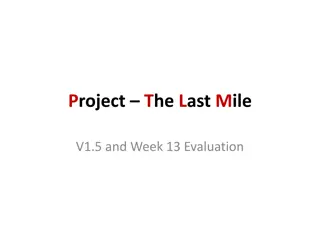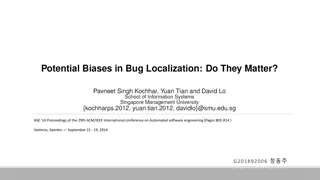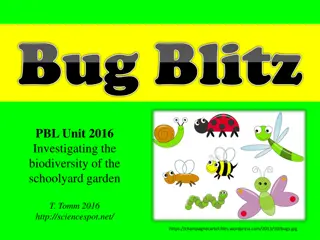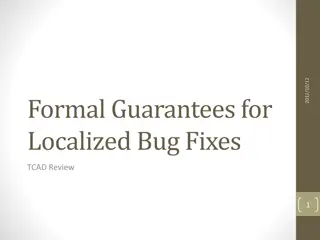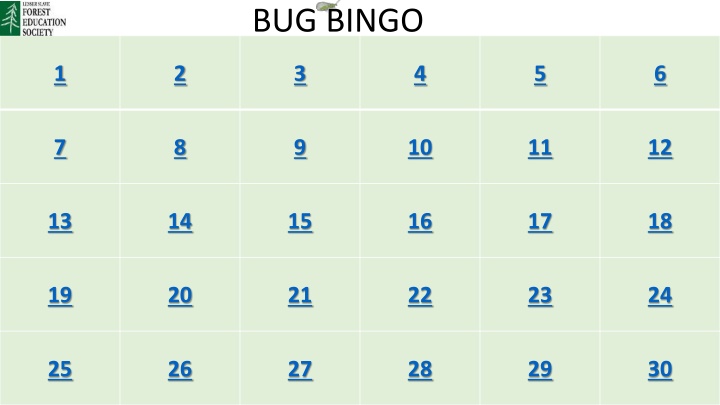
Alberta Insects and Bugs: Learn About Spruce Beetle, Spider, Bumblebee, Carpenter Ant, Mosquito, Lacewing, Snail
Discover the fascinating world of insects and bugs in Alberta. Explore the lives of the Spruce Beetle, Spider, Bumblebee, Carpenter Ant, Mosquito, Lacewing, and Snail. Learn about their habits, importance in the ecosystem, and unique characteristics. Dive into the diverse wildlife that thrives in Alberta's environment.
Download Presentation

Please find below an Image/Link to download the presentation.
The content on the website is provided AS IS for your information and personal use only. It may not be sold, licensed, or shared on other websites without obtaining consent from the author. If you encounter any issues during the download, it is possible that the publisher has removed the file from their server.
You are allowed to download the files provided on this website for personal or commercial use, subject to the condition that they are used lawfully. All files are the property of their respective owners.
The content on the website is provided AS IS for your information and personal use only. It may not be sold, licensed, or shared on other websites without obtaining consent from the author.
E N D
Presentation Transcript
BUG BINGO 1 2 3 4 5 6 7 8 9 10 11 12 13 14 15 16 17 18 19 20 21 22 23 24 25 26 27 28 29 30
Spruce Beetle Spruce Beetle Their full name is the spruce sawyer beetle Their larvae make tunnels called galleries under the bark of old spruce trees Once they are fully grown adults, they will chew their way through the bark of the tree HOME HOME
Spider Spider Spiders are arachnids not insects! They have 8 legs and two main body parts There are about 580 species of spiders in Alberta and most are harmless to humans Spiders eat more insects than birds and bats combined! HOME HOME
Bumblebee Bumblebee Bumblebees are very important because they help pollinate plants! The queen bee lays all the eggs for the hive. Most of the bees are female Bumblebee colonies do not survive the winter. Only the queen bee will survive and build a new nest in the spring. HOME HOME
Carpenter Ant Carpenter Ant They are the biggest type of ants in Alberta They can chew through wood and like to build nests in dead tree trunks, decaying logs, or older houses HOME HOME
Mosquito Mosquito Only female mosquitoes suck blood which they need to develop eggs They lay their eggs in the water since the larvae need water to survive Although mosquitos might seem annoying, they are a very important source of food for animals like birds and bats! HOME HOME
Lacewing Lacewing They get their name from their many- veined wings that look like lace Lacewings are predators and aphids are their favorite food Many lacewings defend themselves by giving off a stinky smell from glands in their thorax HOME HOME
Snail Snail Snails can eat up to 40% of their weight in a day! Snails have one large foot which is a muscle that moves in a wave-like motion to help the snail move Snails like to live in ponds and wet areas to keep their bodies from drying out HOME HOME
Centipede Centipede They are predators and have fangs they use to eat their prey, but they aren't dangerous to humans They don t have 100 legs! They can have as few as 30 legs and always have an odd number of leg pairs They always have one pair of legs for each body segment-millipedes have 2 HOME HOME
Clouded Sulphur Butterfly Clouded Sulphur Butterfly They love to drink nectar from various plants like clover, dandelion, milkweed, and thistles They are very important because they help to pollinate plants Some generations of caterpillars hibernate through the winter They are mud-puddlers which means they often like to suck up nutrients found in mud! HOME HOME
Crane Fly Crane Fly They look like a large mosquito, but Crane flies don't bite Adult crane flies don t eat! The larvae will eat enough nutrients to keep them alive for several days as adults. HOME HOME
Caterpillar Caterpillar Caterpillar is a name for moth or butterfly larvae They spend most of their time eating lots of leaves which can cause damage to plants Some common caterpillars in Alberta include wooly bears, spiny elms, and the larvae of swallowtail butterflies and tussock moths HOME HOME
Wood Ant Wood Ant They have a red head and thorax, and a black abdomen They are very social and work together in groups called colonies Colonies have one queen that gives birth to all the ants in the colony Colonies are almost entirely all females! HOME HOME
Moth Moth Moths often have patterns on their wings that look like eyes to scare away predators Most moths feed on nectar and sap You can tell a moth from a butterfly by looking at the antennae. Moth usually have antennae that look feathered HOME HOME
Caddisfly Caddisfly There are over 200 species of caddisflies in Alberta They are moth-like with long antennae To protect themselves, caddisfly larvae will build themselves a shelter out of pebbles, leaves, twigs, or reeds! Some are even coiled like a snail shell HOME HOME
Lady Beetle Lady Beetle They are also called ladybugs or ladybirds Their favorite food is aphids Ladybugs can be different sizes and different colours like yellow, white, orange, and red Different types of ladybugs can have different numbers of spots- it does NOT relate to their age! HOME HOME
Yellow Jacket Yellow Jacket Yellow jackets are a type of wasp Some make paper nests in trees, and others make their nests in the ground Like bees, only the queen lays eggs. Most yellow jackets are female workers who build and maintain the nest, and a few are males called drones Only females will sting to protect themselves if they feel threatened HOME HOME
Aphid Aphid They are a very important food source for other insects, but they can be harmful to plants There are many types of aphids and they can be green, yellow, black, or patterned. HOME HOME
Millipede Millipede They have 2 pairs of legs per body segment- centipedes only have one They have much fewer than 1000 legs They move very slowly compared to centipedes HOME HOME
Grasshopper Grasshopper Grasshoppers can jump 200x their own size! That s about 20 feet! Their brown or green colouring helps them blend in with grass and dirt in their environment They are closely related to crickets Male grasshoppers often sing by rubbing their wings together to attract females HOME HOME
Pine Beetle Pine Beetle They chew through the bark of pine trees and make tunnels called galleries through the wood They have caused a lot of damage to forests by killing large areas of trees They prefer to live in pine trees that are old HOME HOME
Boreal Bluet Boreal Bluet They are a type of damselfly They aren t always blue! Some can be green or yellow Boreal bluets spend most of their lives as larvae swimming in the water HOME HOME
Beetle Beetle There are about 400 000 species of beetles in the world and over 8000 in Canada! Beetles make up one quarter of all animals on earth! Some beetles (like fireflies) glow in the dark Beetles can both help and hurt the environment. Many species can destroy trees and plants but they also help pollinate flowers and decompose dead material HOME HOME
Horsefly Horsefly They prefer to live around marshes, ponds, or streams which is also where they lay their eggs Horseflies are the fastest flying insect and they can fly up to 140km per hour! They mainly eat nectar from plants, but females also require blood from mammals to produce eggs HOME HOME
Stink Bug Stink Bug They are called stink bugs because they produce a very smelly odor to ward off predators Females will guard the eggs to protect them from predators until they hatch HOME HOME
Dragonfly Dragonfly Dragonflies are predators. They often eat smaller insects which they catch in midair They have such large eyes they can even see behind them HOME HOME
Swallowtail Butterfly Swallowtail Butterfly There are 5 species of swallowtails in Alberta They are found in all provinces and territories in Canada Young swallowtail caterpillars look like bird droppings which helps to disguise them from predators HOME HOME
Daddy Long Daddy Long- -legs legs They have 8 legs but they aren't spiders! They only have one body part, while spiders have 2 Also called harvestman HOME HOME
Tick Tick Ticks are not insects, they are arachnids like spiders Some ticks can carry diseases that can be dangerous for humans and animals You can avoid being bitten by a tick by staying on a clear pathway, wearing bug repellant, and wearing long sleeves and pants HOME HOME
Earthworm Earthworm Earthworms help to mix up nutrients and break down dead material in the soil They have hairs on their body called setae that help them to move Animals like birds, bears, moles, and foxes are all predators of earthworms HOME HOME
Painted Lady Butterfly Painted Lady Butterfly They have beautiful orange, black, and white wings They migrate to Alberta from the southern US about once every 10 years A group of butterflies is called a kaleidoscope! HOME HOME


